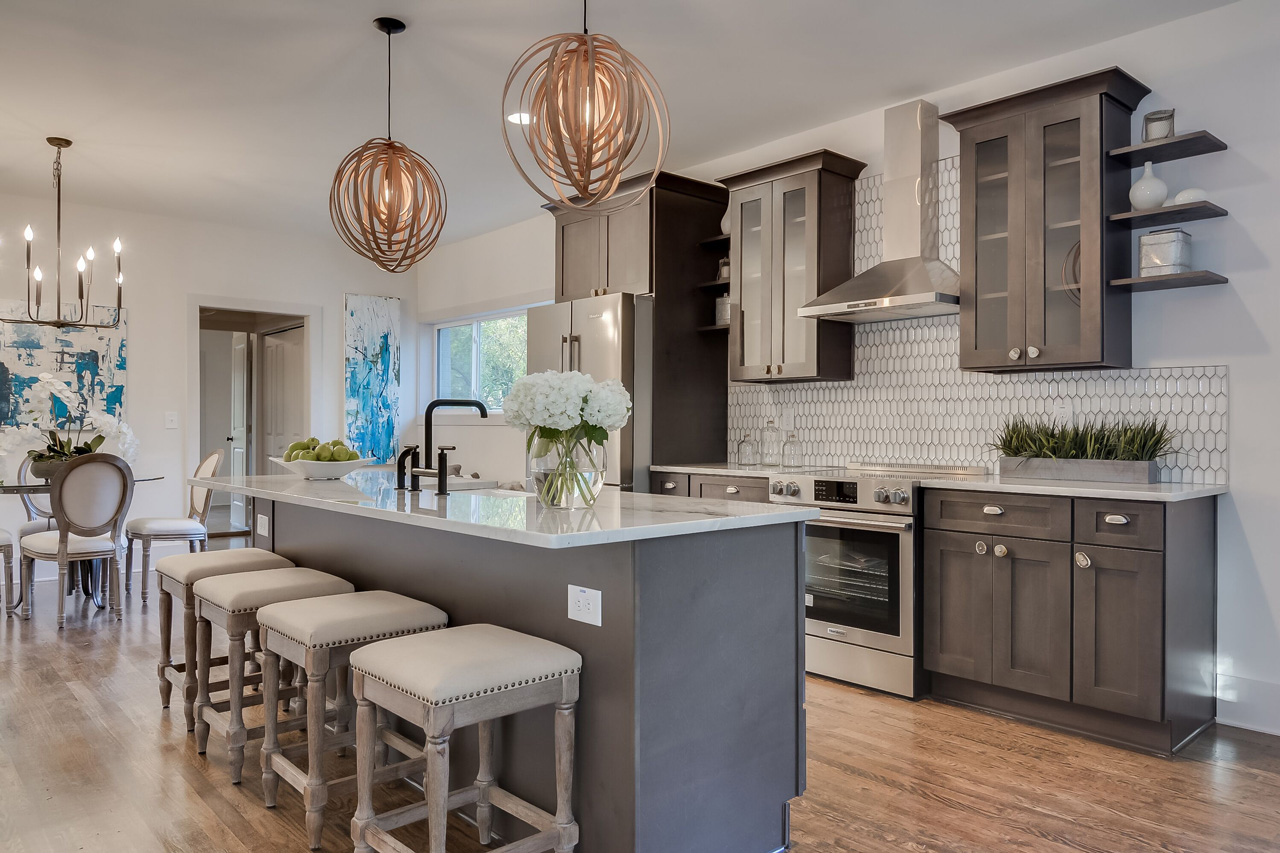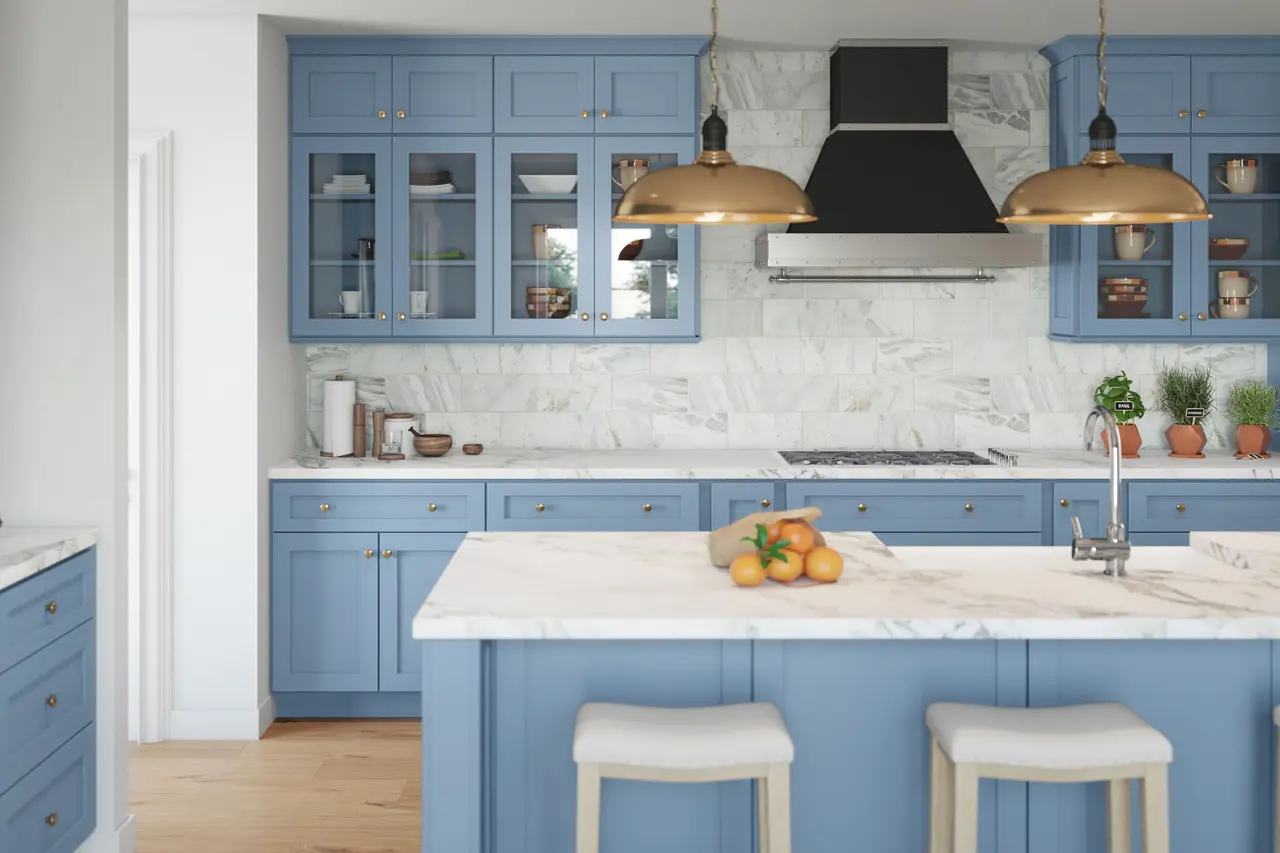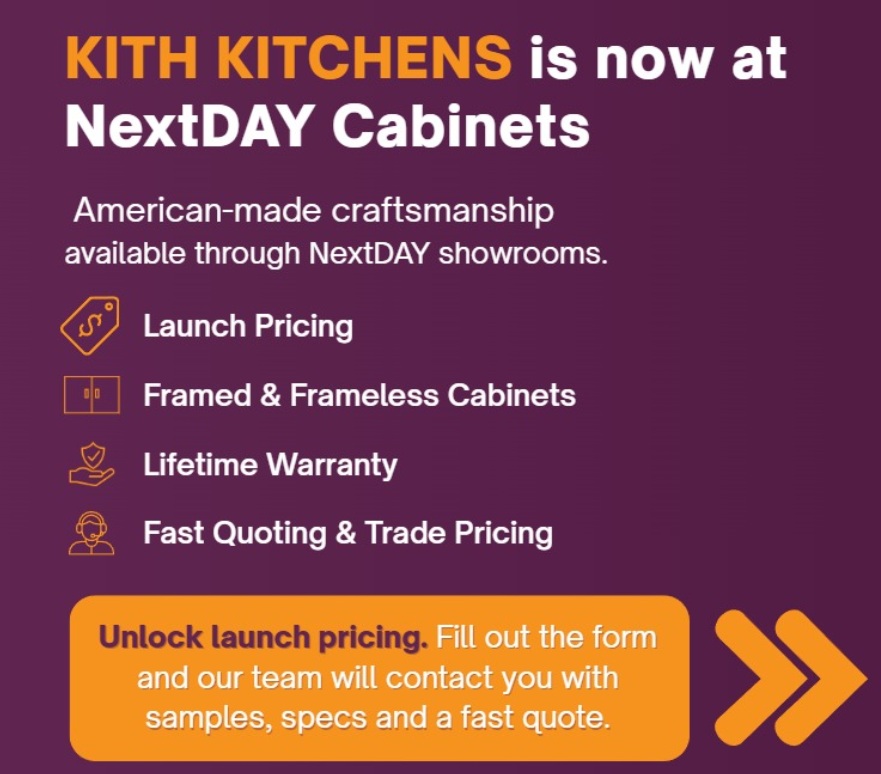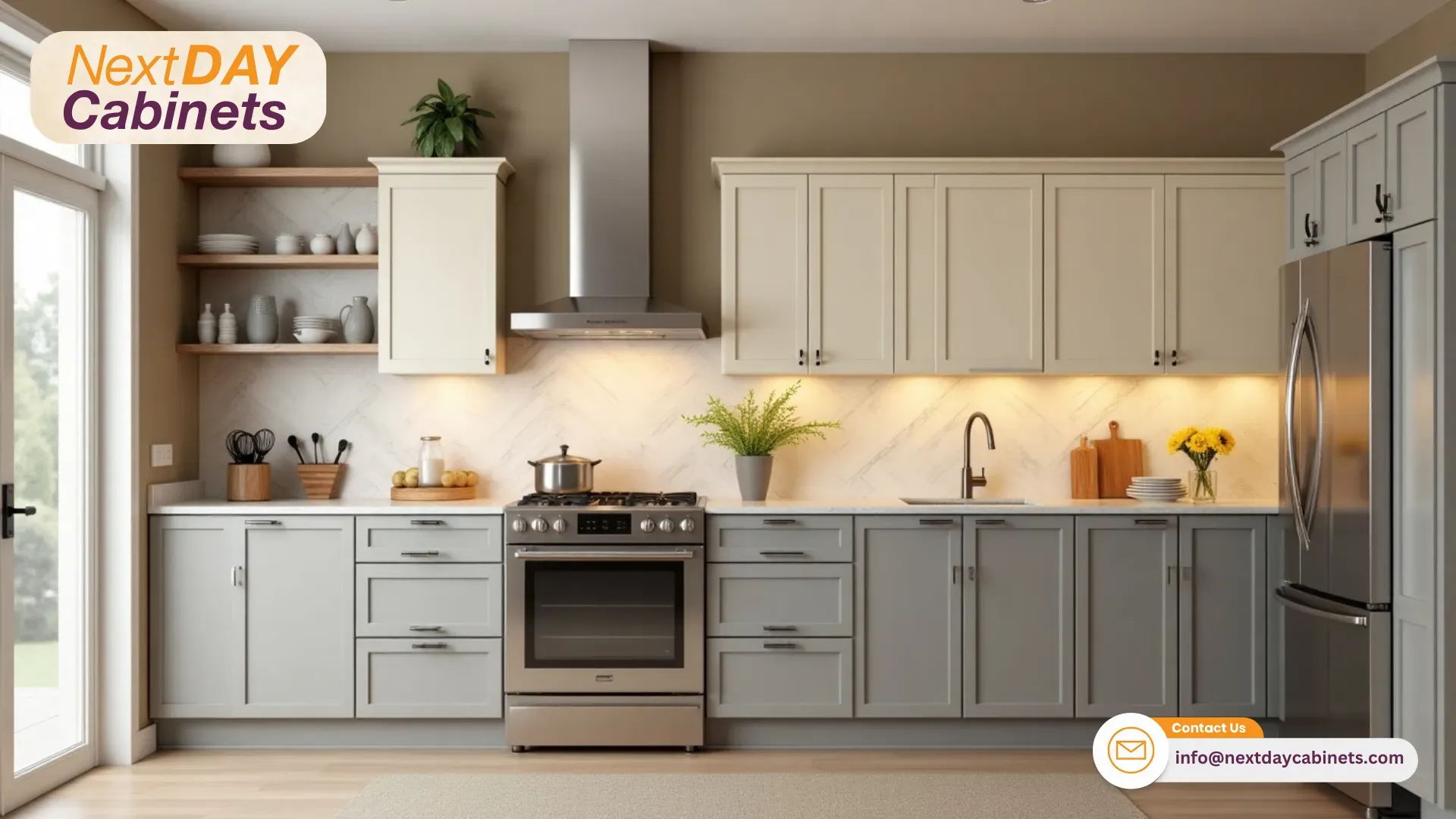
Two-Tone Kitchen Cabinets: Design Strategies That Sell
Walk into any modern kitchen showroom today, and you’ll notice something different from a decade ago. The era of monotone cabinetry—where every door, drawer, and panel matched perfectly—has given way to something far more dynamic. Two tone kitchen cabinets have emerged not just as a design trend, but as a legitimate selling point that contractors and builders are leveraging to win bids and satisfy increasingly design-savvy clients. At NextDAY Cabinets, we’ve watched this shift firsthand as more of our dealer network requests custom color combinations that break traditional mold while maintaining the professional quality that multi-family projects demand.
The appeal is obvious once you understand the psychology behind it. Homeowners aren’t just buying cabinets anymore—they’re investing in a visual experience that defines the heart of their home. Two tone kitchen cabinets offer depth, character, and a sense of intentional design that single-color schemes simply can’t match. For contractors working with NextDAY Cabinets, this translates into higher project values, faster sales cycles, and clients who feel like they’re getting something truly custom without the custom price tag.
Key Takeaways
- Two tone kitchen cabinets command 15-22% higher markups while material costs increase only 8-10%, creating better profit margins for contractors
- Dark lower cabinets paired with light upper cabinets is the proven formula that sells consistently across demographics and markets
- Navy-and-white combinations are currently the highest-performing color scheme for both resale value and client satisfaction
- Multi-family projects see faster rental/sale cycles (up to 3 weeks faster) when featuring two-tone cabinet designs
- Custom paint programs eliminate the premium pricing typically associated with two-tone designs while maintaining quick turnaround times
- Portfolio differentiation through two-tone projects increases bid win rates by an average of 16% for contractors who specialize in these installations
Why Two-Tone Kitchen Cabinets Are a Profitable Choice for Contractors
The Margin Story That Matters
Let’s talk numbers first, because that’s what matters when you’re running a contracting business. The average markup on two tone kitchen cabinets runs about 15-22% higher than standard single-color installations, and here’s the kicker—your material costs don’t increase proportionally. When you’re working with a distributor that offers custom paint programs at wholesale prices, you’re essentially charging for design sophistication while your hard costs remain competitive.
The real profit driver, though, isn’t just in the initial sale. It’s in the referrals and portfolio pieces that follow. A well-executed two-tone kitchen becomes a conversation starter. Homeowners invite friends over, post photos on social media, and suddenly you’ve got warm leads coming in who specifically request “that look with the dark bottom cabinets.” We’ve seen contractors build entire marketing campaigns around a single standout two-tone installation.
Standing Out in the Bidding Process
From a practical standpoint, two tone kitchen cabinets also solve a common problem in the bidding process: differentiation. When you’re competing against three other contractors on a kitchen remodel, and everyone’s quoting similar materials and timelines, the contractor who presents a compelling two-tone design concept often wins the job. It shows creativity and an understanding of current design trends without requiring you to be an interior designer yourself.
What the Market Data Shows
The demand curve supports this strategy too. Recent market research shows that 68% of homeowners under 45 prefer kitchens with some form of color contrast or visual interest over uniform cabinetry. For multi-family developers working with NextDAY Cabinets, this means spec units with two-tone designs rent or sell faster than their single-tone counterparts, sometimes by as much as three weeks in competitive markets.
Professional Designer-Approved Color Combinations
The Classic White-and-Gray Foundation
Not all color combinations are created equal, and this is where contractors can either elevate their game or shoot themselves in the foot. The classic white-and-gray pairing remains popular for good reason—it’s safe, it photographs well, and it appeals to the broadest possible audience. Think crisp white upper cabinets paired with a soft gray-blue on the lowers. This combination works particularly well in kitchens with limited natural light because the white uppers reflect light while the darker lowers ground the space.
| Color Combination | Best For | Market Appeal | Price Point Impact | Resale Value |
|---|---|---|---|---|
| White & Gray | Universal appeal, limited light spaces | Broad (all demographics) | Moderate (+12-15%) | Excellent |
| Navy & White | Traditional/transitional homes | High (35-55 age group) | High (+18-22%) | Excellent |
| Wood & Black | Modern/contemporary projects | Moderate (25-45 age group) | High (+20-25%) | Good |
| Sage/Olive & White | Wellness-focused buyers | Niche (eco-conscious) | Moderate (+15-18%) | Good |
| Cream & Warm Gray | Transitional spaces | High (45+ age group) | Moderate (+12-16%) | Excellent |
| Black & Light Wood | Urban/loft settings | Niche (under 40) | High (+22-28%) | Good |
Navy Blue: The Dark Horse Winner
But here’s where it gets interesting: navy blue has become the dark horse of two tone kitchen cabinets. A deep navy on lower cabinets paired with white or cream uppers creates a sophisticated look that feels both timeless and current. The navy provides enough contrast to make a statement without the starkness of black, and it pairs beautifully with both warm and cool metal finishes. We’ve seen this combination work exceptionally well in colonial and transitional homes where the architecture can support a bolder choice.
Modern Minimalism with Wood and Black
For contractors working on modern or contemporary projects, the natural wood and matte black combination is where the market’s heading. Picture walnut or white oak lower cabinets with matte black uppers, or vice versa. This pairing brings warmth and organic texture while maintaining clean, modern lines. The key is ensuring the wood tone has enough richness to hold its own against the black—pale or washed-out wood doesn’t create enough contrast.
The Emerging Green Movement
Green has also entered the conversation in a serious way, specifically sage and olive tones. When paired with natural wood or warm white, these earthy greens create a connection to nature that resonates with buyers interested in organic, wellness-focused design. It’s a slightly riskier choice that works best when you’re targeting a specific demographic or creating a signature look for a development.
Avoiding the Creativity Trap
The mistake many contractors make is trying to be too creative with color combinations. Stick with proven pairings until you’ve built confidence and a portfolio. Your job isn’t to reinvent color theory—it’s to deliver installations that sell homes and satisfy clients while protecting your margins.
 Color Distribution Strategy: Which Approach Sells Best?
Color Distribution Strategy: Which Approach Sells Best?
The Golden Rule: Dark Below, Light Above
Here’s a fundamental principle that will save you from costly mistakes: dark on bottom, light on top. This isn’t just aesthetic preference—it’s basic visual psychology. Darker lower cabinets anchor the space and hide the inevitable wear and tear that happens near the floor. Lighter upper cabinets prevent the kitchen from feeling cave-like and make ceilings appear higher. When you walk potential clients through this logic, they get it immediately.
Creating Intentional Contrast
The contrast you create between upper and lower cabinets should be intentional and significant. Wishy-washy combinations where the two colors are only slightly different end up looking like a mistake or like the contractor couldn’t afford enough of one color. If you’re going two-tone, commit to it. The difference should be obvious from across the room.
The Island Exception Strategy
One strategy that’s gaining traction involves taking the lighter color down to include the island or peninsula. So instead of a straight split at the counter line, you might have white uppers, white island, and navy perimeter lowers. This creates a focal point and gives the eye a resting place in the center of the kitchen. It’s particularly effective in open-concept homes where the island is visible from the living area.
Adapting for Smaller Spaces
For galley or smaller kitchens, consider running the darker color on just one wall of lowers while keeping everything else light. This creates visual interest without overwhelming a compact space. The darker accent wall becomes a feature rather than making the whole kitchen feel smaller.
Getting the Transition Point Right
The height at which you split colors matters more than most contractors realize. The standard approach—light above the countertop, dark below—works because it aligns with the natural sightline and the functional division of the space. Breaking this rule can work in specific architectural contexts, but it requires a designer’s eye to pull off successfully.
NextDAY’s Custom Paint Program Advantages for Two-Tone Projects
Flexibility Without the Wait Time
This is where working with the right distributor makes all the difference. NextDAY Cabinets’ custom paint program was essentially built for the two-tone revolution. Instead of being limited to stock colors or waiting weeks for custom orders from manufacturers, you can specify exactly the combination you need and still maintain quick turnaround times that keep your projects on schedule.
Extended Color Palette Access
The program gives you access to an extensive color palette that goes beyond the basic whites, grays, and browns that dominated the market five years ago. Whether you need that specific shade of navy that matches your client’s inspiration photo or a custom green that complements their tile selection, the flexibility is there without the usual premium pricing that comes with custom work.
Saying Yes When Others Can’t
For contractors, this flexibility translates directly into competitive advantage. You can say yes to color combinations that other contractors have to turn down or quote at prohibitive prices. When a homeowner falls in love with a specific two-tone look they saw online, you’re not stuck trying to talk them into whatever happens to be in stock. You can actually deliver what they want at a price point that makes sense for everyone.
Quality Control Across Colors
The quality control on custom paint work is another factor that shouldn’t be overlooked. When you’re mixing colors or dealing with multiple suppliers for a two-tone project, you risk variations in sheen, texture, and color accuracy. Working with a single source that understands how the colors need to coordinate eliminates those headaches. The upper and lower cabinets arrive finished to the same standards, with matching sheen levels and coordinated undertones.
Protecting Your Timeline and Reputation
From a scheduling perspective, having reliable lead times on custom color combinations means you can promise delivery dates with confidence. Nothing kills a contractor’s reputation faster than delays, and custom cabinetry is notorious for pushing timelines. When you can deliver two tone kitchen cabinets on a next-day timeline—or close to it—you’re operating at a level most of your competition can’t match.
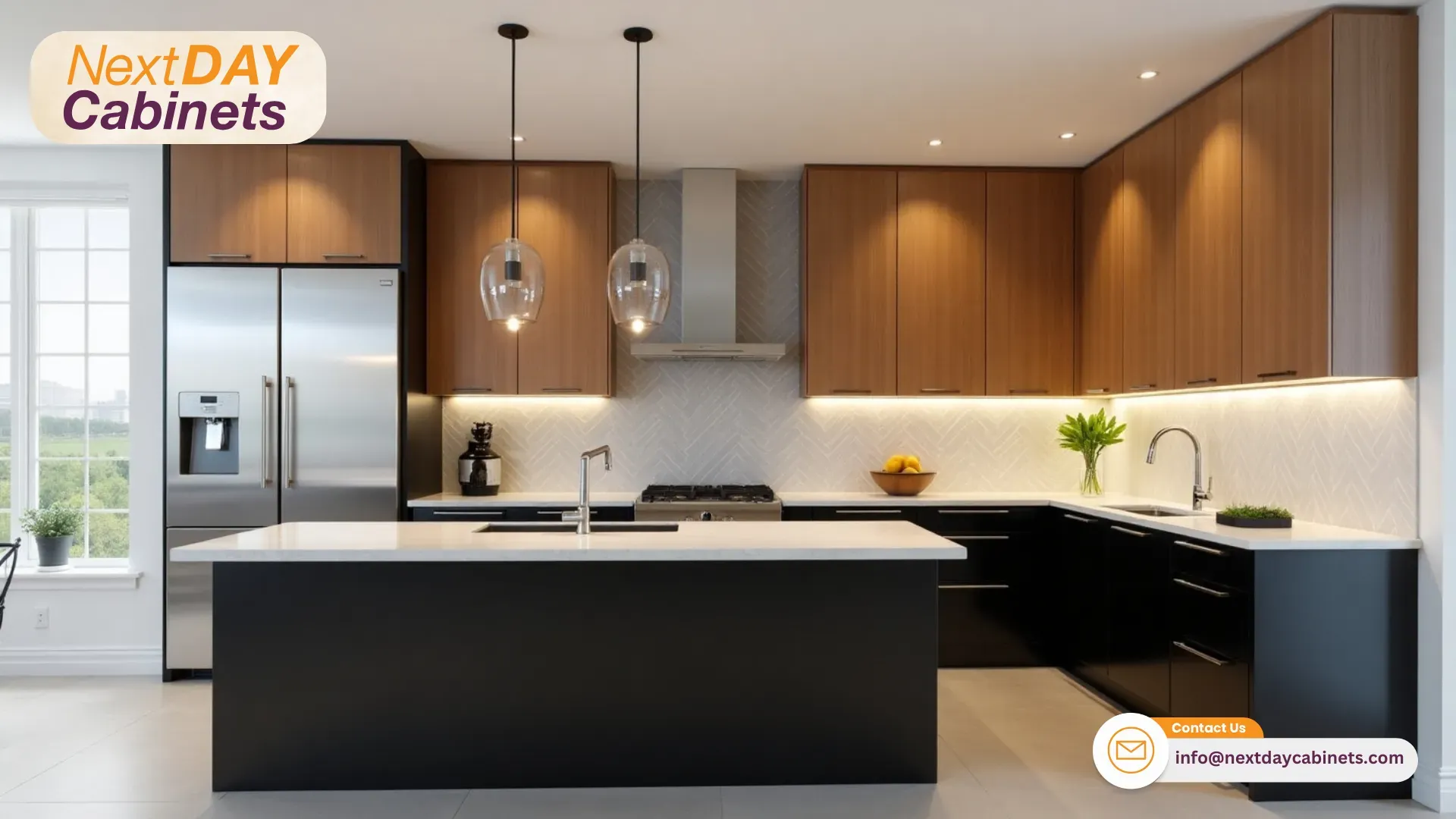 Two-Tone Cabinets in Multi-Family Projects
Two-Tone Cabinets in Multi-Family Projects
Balancing Standardization with Distinction
Multi-family developments present unique opportunities for two tone kitchen cabinets because you’re balancing standardization with the need to create units that feel designed and desirable. Property developers have figured out that units with distinctive design elements rent or sell faster and often command premium pricing. A smart two-tone cabinet strategy delivers that distinctiveness without destroying your per-unit costs.
Choosing Combinations for Scale
The key is selecting combinations that work across multiple unit types and orientations. You might choose a navy-and-white scheme for a 200-unit development because it photographs well, appeals to a broad demographic, and doesn’t clash with varying natural light conditions in different units. This standardization lets you order in volume, which is where your margins really start to work in your favor.
Creating Tiered Offerings
One effective approach for multi-family work is creating tier systems. Your base units might feature a simple white-and-gray two-tone design, while premium units on higher floors or with better views get the navy-and-white or wood-and-white treatment. This lets buyers or renters self-select into their preference while you’re still managing a limited number of SKUs across the project.
The Maintenance Advantage
The maintenance factor becomes crucial in multi-family contexts. Two tone kitchen cabinets, particularly with darker lowers, actually reduce the visible wear that causes property managers headaches between tenants. Scuffs and marks that would be glaring on all-white cabinets simply don’t show on navy or gray lowers. This means less touch-up work and longer intervals between full repaints.
Volume Pricing That Changes the Game
For contractors specializing in multi-family work with NextDAY Cabinets, the volume discounts on larger orders mean you can deliver sophisticated two-tone designs at price points that work within developer budgets. When you’re ordering 50 or 100 kitchens at once, the per-unit cost on custom colors becomes negligible while the perceived value remains high.
The Psychology of Color That Increases Sales
White Plus Warmth
Understanding why certain color combinations trigger buying decisions gives you an edge in both securing contracts and satisfying clients. White cabinets signal cleanliness and modernity, but they can also read as cold or generic. When you pair white uppers with warmer wood-tone or colored lowers, you’re softening that clinical edge while maintaining the bright, open feeling that sells.
Dark Colors Signal Quality
Dark colors on lower cabinets create a sense of quality and luxury. There’s a reason high-end kitchen brands gravitate toward deep navies, blacks, and charcoal grays—these colors feel substantial and expensive. For contractors, this means you can elevate the perceived value of a mid-range kitchen by making strategic color choices rather than upgrading to premium wood species or exotic materials.
Contrast Communicates Intentionality
The contrast itself sends a message about intentional design. A kitchen with two tone kitchen cabinets signals that someone thought carefully about the space, that decisions were made deliberately rather than just going with whatever was cheapest or easiest. This matters enormously to buyers who want their home to feel custom and personal rather than builder-grade.
Demographic Color Preferences
Different demographics respond to color in predictable ways that smart contractors can leverage. Younger buyers, particularly millennials and Gen Z, gravitate toward bolder choices like navy, forest green, or black paired with wood tones. They’re more willing to embrace color and less concerned about resale value decades down the line. Older buyers tend to prefer safer combinations like white-and-gray or white-and-light-blue that feel classic and won’t date quickly.
Regional Considerations Matter
Regional preferences play a role too. Coastal markets respond well to whites paired with soft blues or grays that echo beach and water themes. Urban markets skew toward more dramatic combinations with black or navy. Suburban and rural areas often prefer warmer palettes with wood tones and earth colors. Knowing your market means you can present options that feel right to your client base rather than showing them everything and hoping something sticks.
The Practical Side of Finish Selection
The finish matters as much as the color. Matte and satin finishes on two tone kitchen cabinets create a more modern, sophisticated look compared to high-gloss options. They’re also more forgiving with fingerprints and smudges, which matters to anyone actually using their kitchen. When you explain this practical benefit alongside the aesthetic appeal, you’re selling both beauty and functionality.
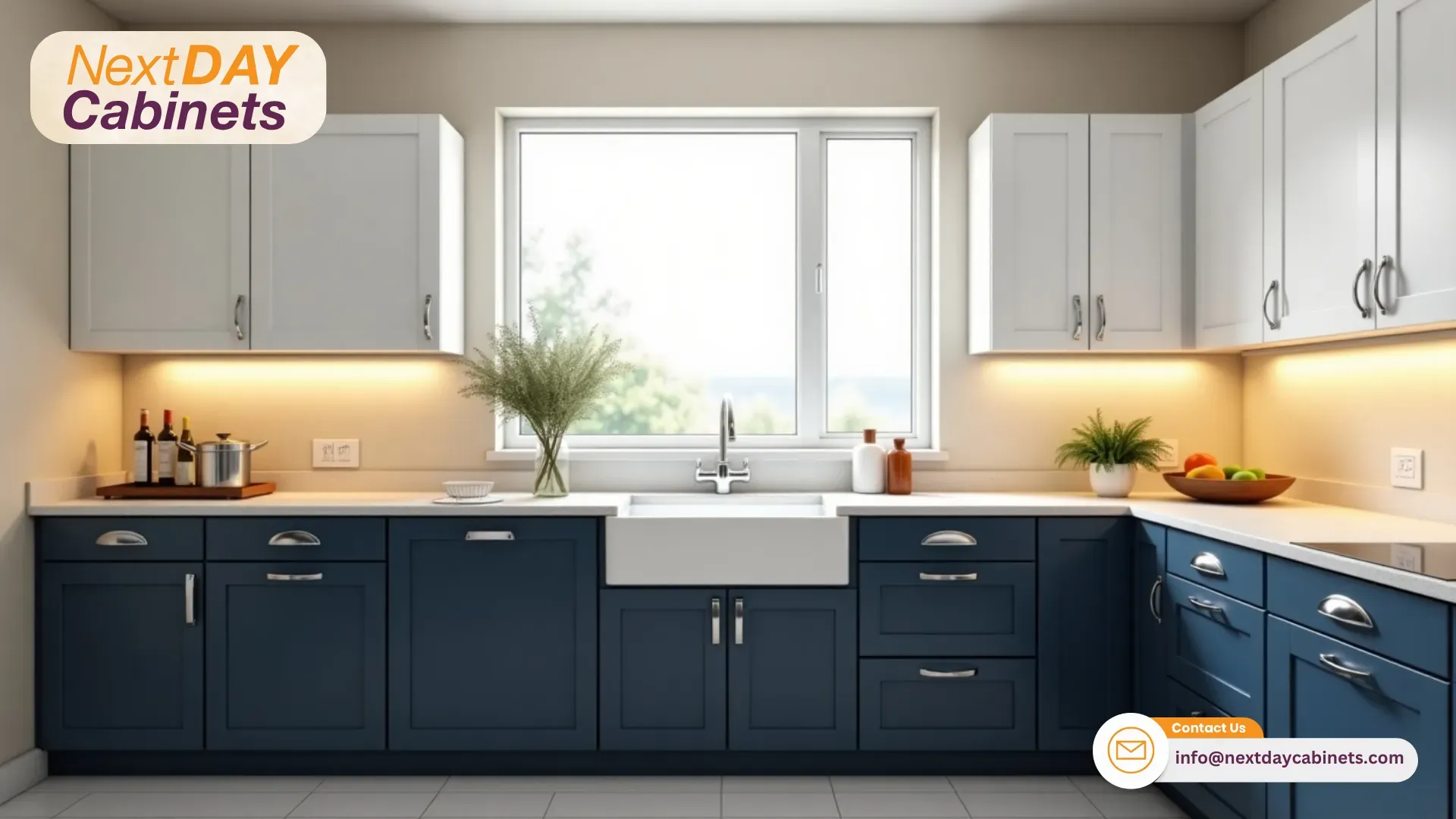 Technical Details and Installation Strategies
Technical Details and Installation Strategies
Ensuring Finish Consistency
The execution of two tone kitchen cabinets requires more planning than single-color installations, but the process isn’t dramatically different if you approach it systematically. The first technical consideration is ensuring your paint or finish quality is consistent across both colors. Nothing looks worse than two colors with different sheen levels or surface textures. When you’re sourcing from a single distributor with quality control standards, this becomes a non-issue.
Trim and Molding Decisions
Crown molding and trim decisions become more significant in two-tone designs. You need to decide whether trim elements match the uppers, the lowers, or introduce a third neutral color. The most common and successful approach is matching crown and upper trim to the upper cabinet color while matching toe kicks and any lower trim to the lower cabinets. This creates clean visual lines without introducing too many color breaks.
Strategic Transition Points
The transition point between colors should align with logical architectural elements. The countertop provides an obvious division point, but you might also consider aligning color breaks with backsplash edges, window sills, or ceiling beams depending on the specific kitchen layout. The goal is making the color transition look intentional and connected to the architecture rather than arbitrary.
Hardware Selection for Two-Tone Designs
Hardware selection becomes more complex with two tone kitchen cabinets because your pulls and knobs need to work with both colors. Brushed nickel and stainless steel are safe choices that complement virtually any color combination. Matte black hardware has become incredibly popular because it adds contrast without competing with the cabinet colors. For warmer palettes involving wood tones, brass and gold finishes create a cohesive, luxe feel.
Installation Efficiency Tips
From an installation efficiency standpoint, two-tone projects don’t require significantly more labor than single-tone once you’ve got your system down. The key is careful labeling during delivery and staging cabinets by color before you start hanging. Nothing eats into your margin faster than having to backtrack because you installed upper cabinets in the lower color or vice versa. A few extra minutes of organization on the front end saves hours of frustration.
Why Construction Quality Matters
The all-wood construction that NextDAY Cabinets provides makes a difference in two-tone installations because the paint adhesion and finish quality are superior to particle board or MDF alternatives. Real wood accepts paint evenly and holds up better over time, which means fewer callbacks for touch-ups or finish failures. When you’re standing behind your work with a warranty, that construction quality protects your reputation and your bottom line.
Pricing Strategy for Two-Tone Cabinet Proposals
Break Out the Design Value
This is where contractors often leave money on the table. Two tone kitchen cabinets should be priced as a design upgrade, not just a material cost. When you’re putting together a proposal, break out the two-tone design as a line item that highlights the additional value. Something like “Premium Two-Tone Cabinet Design Package” commands respect and justifies the upcharge in a way that burying it in a single cabinet line item doesn’t.
Understanding Your Markup Opportunity
Your markup should reflect both the material reality and the perceived value. Even if your hard costs only increase by 8-10% for the second color, you should be marking up by at least 15-20% to account for the design service, the additional planning, and the sophisticated result you’re delivering. Clients who want two tone kitchen cabinets understand they’re choosing something more distinctive and are generally willing to pay for it.
| Project Type | Material Cost Increase | Recommended Markup | Average Project Value Increase | Typical Timeline Impact |
|---|---|---|---|---|
| Single Kitchen Remodel | 8-10% | 15-20% | $4,500-$6,500 | +2-3 days |
| Multi-Family (10-50 units) | 6-8% | 12-18% | $2,800-$4,200 per unit | +1-2 days per unit |
| Multi-Family (50+ units) | 5-7% | 10-15% | $2,200-$3,500 per unit | +1 day per unit |
| Luxury Custom Home | 10-12% | 20-28% | $8,000-$12,000 | +3-5 days |
| Spec Home Development | 7-9% | 14-19% | $3,500-$5,500 | +2-3 days |
| Commercial/Office | 9-11% | 16-22% | $5,500-$8,500 | +2-4 days |
The Good-Better-Best Framework
One effective pricing strategy is creating good-better-best proposal options where the base option is single-tone, the mid-tier is a subtle two-tone combination like white-and-gray, and the premium option is a bolder choice like navy-and-white or wood-and-black. This lets clients self-select into their comfort zone while you’re still moving them toward the higher-margin two-tone options.
Leveraging Your Volume Advantages
When competing on bids, particularly for multi-family projects, use your volume discount advantages strategically. You can come in competitive on price while still delivering two-tone sophistication because your costs through NextDAY’s dealer network are lower than contractors working with retail suppliers or premium custom shops. This is your unfair advantage—use it.
Selling Value Before Cutting Price
Be transparent about where the value comes from. Walk clients through the design thinking, show them inspiration photos of similar kitchens, explain how the color combination will photograph for resale. When people understand why they’re paying more, they’re much more comfortable with the investment. You’re not just selling cabinets—you’re selling the vision of what their kitchen becomes.
Handling Price Objections
Don’t discount too quickly when you get pricing pushback. If a client balks at your two-tone pricing, first try selling the value harder rather than immediately cutting your margin. Show additional examples, bring in testimonials from previous clients, offer to connect them with past customers who chose similar designs. Often, hesitation isn’t about the actual price—it’s about confidence in the decision.
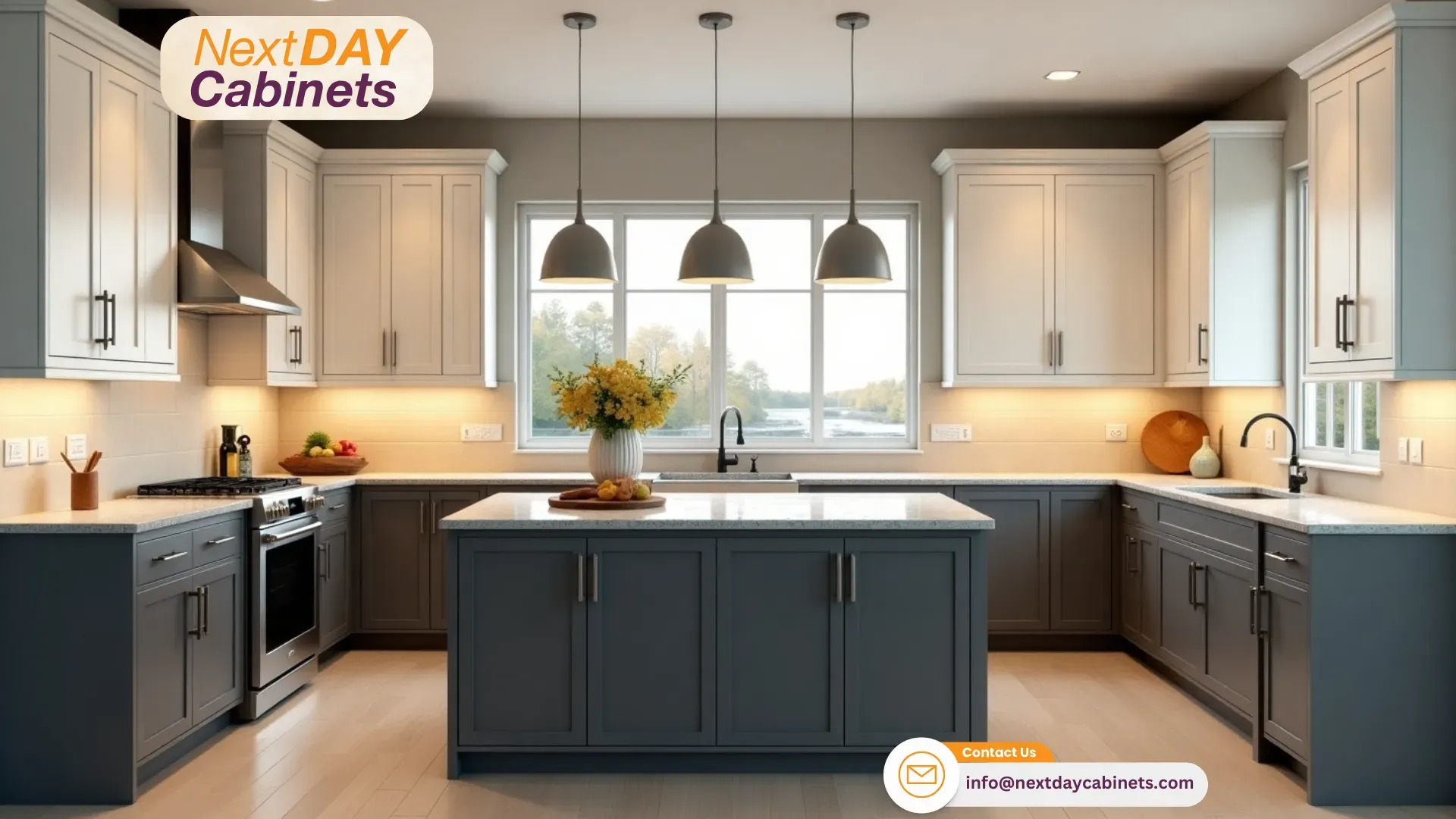 2026 Trends in Two-Tone Kitchen Cabinets
2026 Trends in Two-Tone Kitchen Cabinets
The Shift Toward Warmth
The market is definitely moving toward warmer, more organic palettes as we progress through 2026. The stark white-and-gray combinations that dominated five years ago are giving way to creams, taupes, and greige tones paired with natural woods or soft blues and greens. This shift reflects broader design trends toward biophilic design and creating homes that feel nurturing rather than just stylish.
Texture Becomes a Player
Expect to see more texture in two-tone applications. This might mean pairing smooth painted uppers with wood-grain lowers, or combining matte finishes with subtle sheen variations. The goal is creating visual interest through both color and surface quality rather than relying on color contrast alone. For contractors, this means paying closer attention to finish specifications and helping clients understand how texture contributes to the overall effect.
Islands as Statement Pieces
Colored islands are becoming standard rather than exceptional. Rather than just splitting upper and lower cabinets between two colors, designers and homeowners are getting bolder about making the island a distinct third element. You might see a kitchen with white perimeter cabinets and a sage green island, or gray cabinets with a walnut island. This creates a focal point and allows for more personality without overwhelming the entire space.
Sustainability Influences Color
Sustainability is influencing color choices in interesting ways. Clients are increasingly asking about low-VOC paints and natural wood finishes, and they’re gravitating toward earth tones that signal environmental consciousness. Colors like terracotta, olive, and various shades of brown and tan are resonating with buyers who want their homes to reflect their values. Smart contractors are getting ahead of this by familiarizing themselves with eco-friendly finish options.
The Evolution of All-White
The all-white kitchen isn’t dead, but it’s definitely losing market share to more complex schemes. Even clients who initially come to you requesting all-white cabinets can often be guided toward a subtle two-tone approach that gives them the brightness they want while adding depth and character. A white kitchen with slightly darker or warmer lowers—think cream or light gray—satisfies the desire for lightness while avoiding the sterile look that all-white can create.
Black Gains Confidence
Black is being used more confidently, particularly in urban markets and with younger demographics. Where contractors might have shied away from black cabinets five years ago, it’s now a legitimate option that, when executed well, creates stunning results. Black lowers with white or light wood uppers work particularly well in modern and transitional kitchens. The key is ensuring adequate lighting so the space doesn’t feel dark or closed in.
Success Stories from Contractors in the Field
The Townhome Development Win
The proof is always in the projects. We’ve worked with contractors who’ve built their entire business differentiation around expertly executed two tone kitchen cabinets, and their results speak volumes. One builder in the mid-Atlantic region standardized on a white-and-navy scheme across an entire development of townhomes. The units sold 40% faster than comparable properties in the area, and buyer feedback consistently mentioned the kitchens as a deciding factor.
The Conversion Rate Transformation
Another contractor specializing in kitchen remodels tracked his conversion rates before and after he started leading with two-tone proposals. His close rate improved from about 32% to 48% over an 18-month period. More importantly, his average project value increased by nearly $6,000 because clients who chose two-tone designs were also more likely to upgrade countertops, backsplashes, and lighting to complement their cabinets.
Multi-Family ROI That Speaks
A multi-family developer working on a 300-unit property in the Midwest shared that units with two tone kitchen cabinets rented at a $150 monthly premium over identical units with single-tone cabinets—a difference that adds up to $54,000 in annual revenue across the property. The additional cost to achieve this was less than $400 per unit. That’s an ROI that makes developers take notice and keeps them coming back for the same treatment on future projects.
The Satisfaction Factor
Customer satisfaction metrics tell a similar story. Contractors who deliver well-executed two-tone kitchens report higher satisfaction scores and more referrals than those doing standard installations. There’s something about the visual impact of walking into a finished two-tone kitchen that generates genuine excitement. Clients feel like they received something special, something that reflects current design thinking, and that emotional response translates into positive reviews and word-of-mouth marketing.
Building Dealer Relationships
The dealers in NextDAY Cabinets‘ network who’ve embraced two-tone strategies consistently report stronger relationships with their contractor clients because they’re helping them win more bids and satisfy more customers. When you can deliver custom color combinations at competitive prices with reliable timelines, you become an invaluable partner rather than just a supplier. That relationship depth is what sustains a contracting business through market cycles and competitive pressure.
Making Two-Tone Cabinets Your Competitive Advantage
Build Your Portfolio Strategically
The kitchen cabinet market is crowded with contractors offering similar products at similar prices, so standing out requires something beyond just competitive bidding. Two tone kitchen cabinets represent an opportunity to differentiate yourself as a contractor who understands design, who can deliver current trends, and who brings more to the table than just installation labor.
Start by building a portfolio of two-tone projects that showcase range and versatility. You need examples of safe, broadly appealing combinations as well as bolder choices that demonstrate your capabilities. These portfolio pieces become your most powerful sales tool—not just photos on a website, but case studies you can discuss with detail and authority. When a potential client sees that you’ve done this work successfully multiple times, their confidence in choosing you skyrockets.
Cultivate Design Professional Relationships
Develop relationships with interior designers and real estate stagers in your market. These professionals are often looking for contractors who can execute current trends reliably. When a designer knows you’re comfortable with two-tone cabinetry and can deliver it on schedule, you become one of their go-to referrals. This opens up a client stream that’s pre-sold on design value and less focused on being the absolute lowest bidder.
Become the Guide, Not Just the Builder
Invest time in understanding design principles beyond just construction. You don’t need to become an interior designer, but knowing why certain color combinations work, how to balance proportions, and what’s driving current trends makes you a more valuable partner to your clients. This knowledge lets you guide rather than just execute, and clients pay premiums for guidance.
Leverage Your Dealer Partnership
Use your dealer relationship with NextDAY Cabinets strategically. The combination of quality all-wood construction, custom paint capabilities, and reliable timelines is a powerful value proposition that separates you from contractors working with big-box stores or inconsistent suppliers. When you can promise and deliver custom two-tone designs without the wait times and premium pricing typically associated with custom work, you’re playing a game your competition isn’t equipped for.
Position for the Future
The future of kitchen design is definitely heading toward more personalization, more color, and more thoughtful contrasts. Two tone kitchen cabinets are positioned right at the center of these trends, making them not just a current opportunity but a long-term strategy. Contractors who develop expertise now will have a significant advantage as these designs continue to gain market share. NextDAY Cabinets is committed to supporting our dealer network with the products, flexibility, and service that make these projects profitable and repeatable. Whether you’re doing one-off remodels or managing large-scale developments, the two-tone approach offers a clear path to higher margins, happier clients, and a business that stands out in an increasingly competitive market.
Why Choose NextDAY Cabinets?
- Guaranteed Lowest Price: We ensure customer happiness and loyalty by providing top-quality construction at low factory-direct prices.
- Fast Lead Times: We offer some of the fastest lead times in the industry, with many orders ready in just 3-5 days.
- Professional Design Services: Our experienced design consultants help you create the perfect kitchen for your needs.
- High-Quality Products: All our cabinets are made from 100% solid wood and are KCMA certified, ensuring durability and environmental safety.
NextDAY Cabinets offers the best American made cabinet brands like:
Shiloh Cabinetry, Crestwood, GoldenHome Cabinets, Decora, Forevermark Cabinetry, Mantra, Marsh, Nations Cabinetry, Waypoint, WellKraft Cabinetry, Wolf Home Product in Mid-Atlantic area with 6 showrooms in Chantilly, Alexandria, Woodbridge, Richmond, Beltsville, and Chicago.
Frequently Asked Questions About Two-Tone Kitchen Cabinets
Are two-tone kitchen cabinets still in style in 2026?
Yes, absolutely. Two tone kitchen cabinets have evolved from a trend into a design staple. The approach has matured with warmer palettes and more sophisticated color relationships. For contractors, this staying power makes two-tone installations a safe recommendation that won’t feel dated.
Should upper or lower cabinets be darker in a two-tone kitchen?
Darker lowers and lighter uppers is the standard recommendation. Dark lower cabinets hide scuffs and daily wear, while light uppers prevent the kitchen from feeling heavy and make ceilings appear higher. This configuration works in most kitchens and is easiest to sell to clients.
What’s the best color combination for two-tone cabinets?
Navy and white currently leads in client satisfaction and resale value. White and gray remains the safest choice for broad appeal. For contemporary projects, natural wood paired with matte black creates stunning results. The best combination depends on your target market and the home’s architecture.
Do two-tone kitchen cabinets cost more than single-color cabinets?
Material costs typically increase by 8-12% when working with distributors like NextDAY Cabinets. However, retail pricing should reflect a 15-25% premium for the design sophistication you’re delivering. Installation labor doesn’t significantly increase once you have a system in place.
Can I make just the island a different color, or do all lower cabinets need to match?
A contrasting island is one of the most popular two-tone approaches. It creates a focal point and works beautifully in open-concept homes. The island can be bold—navy, black, forest green—while perimeter cabinets remain neutral for the best of both worlds.
How do I choose hardware for two-tone cabinets?
Choose hardware that works with both cabinet colors. Brushed nickel and stainless steel complement virtually any combination. Matte black hardware is extremely popular for providing contrast. For warmer palettes with wood tones, brass or gold finishes work well.
Will two-tone cabinets make my small kitchen look smaller?
Done correctly, two tone kitchen cabinets actually make small kitchens appear larger. Lighter upper cabinets draw the eye upward, creating height, while darker lowers ground the space. The key is maintaining the light-on-top, dark-on-bottom hierarchy with adequate lighting.
How do I maintain two-tone cabinets differently than single-color cabinets?
Maintenance is essentially identical to single-color cabinets. Darker lower cabinets actually hide dirt and wear better than all-white installations. Clean with mild soap, warm water, and a soft cloth—the same as any quality cabinetry.
